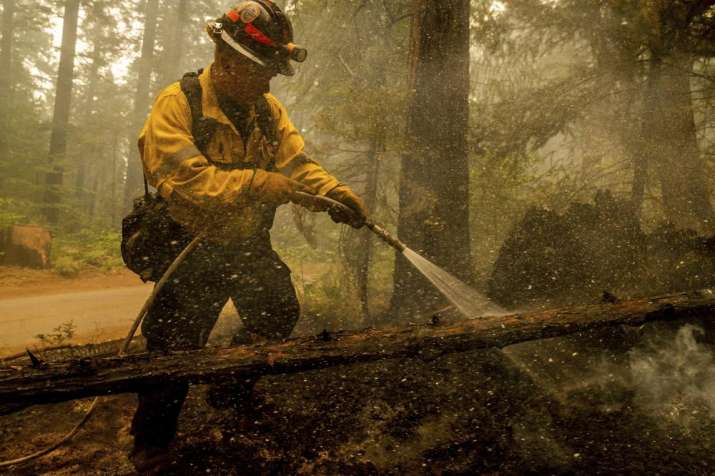
Central Calaveras firefighter Ryan Carpenter extinguishes flames from the Caldor Fire on Hazel Valley Road east of Riverton, Calif.
Workers were digging and burning fire lines amid another round of high winds that contributed to the fury of northern California wildfires.
“We have a firefight ahead of us and the wind is going to make it very challenging today,” Keith Wade, a spokesman for the California Department of Forestry and Fire Protection, or Cal Fire, said Saturday.
The Caldor fire has already destroyed dozens of homes in the northern Sierra Nevada, and officials on Friday closed a 46-mile (74-kilometer) section of Interstate 50, which runs between the state capital Sacramento and Lake Tahoe on the state of Nevada. Beach is the main road. Line.
The highway was closed after debris from the fire fell onto the road and “extremely dry” as of Saturday evening due to a red flag warning for 20- to 30-mph (32- to 48-kph) winds. The result combined with the fuel would be severe fire weather conditions in the vicinity of the Caldor Fire,” the National Weather Service said.
Winds are likely to reach 40 mph (65 kph) on Saturday.
The road is an important checkpoint as crews struggle against the fire, which erupted earlier this week and was caused by winds up to 10 times in a few days.
“We’re going to invest everything we have in catching the fire south of the road,” said Eric Schwab, an operations section chief at Cal Fire.
Firefighters progressed to the west side of the fire and starved it of fuel to burn vegetation and stop the flames from moving into the empty community of Pollock Pines. Fire officials said that on the northeast side, in a densely forested area, crews were guarding cabins.
The Caldor fire had now consumed about 130 square miles (310 square kilometers) as of Saturday and more than 1,500 firefighters were battling it through heavy woods and rough terrain.
The fire was one of nearly a dozen large California wildfires that have scorched northern California, burning at least 700 homes in and around the Sierra Nevada communities of Greenville and Grizzly Flats alone.
The fire, mainly in the northern part of the state, has burned about 1.5 million acres, or about 2,300 square miles (6,000 square kilometers) and sent smoke to the East Coast. They were burning in grass, brush and forest that is exceptionally dry with the prospect of a two-year drought caused by climate change.
Thousands of homes in natural forested communities are at risk and evacuation orders are in place for tens of thousands.
Nine national forests in the region have been closed due to the threat of fire.
To the northwest of the Caldor Fire, the massive Dixie Fire continued to expand and new evacuations were ordered, including the small village of Taylorsville. In five weeks, the fire, about 175 miles (282 kilometers) northeast of San Francisco, has become the second largest fire in the state’s history and blackened an area twice the size of Los Angeles.
Weather forecasts call for a storm system that winds through northern California early next week but will bring little rain. This will increase the risk of fire. There have been dozens of explosions in recent days but they were quickly sealed.
The one exception was the Cache Fire, a small but fast-moving grass fire that destroyed at least 56 homes and destroyed a mobile home park. Some of those forced to escape the flames had to leave their pets behind.
Emily Crum, an animal control officer with North Bay Animal Services, was surprised when she discovered abandoned pets in the Clearlake area. He saw a black dog in the burnt lot.
“I saw her lying there. I thought she was dead,” said Krum. “Then she started wagging her tail.”
Crum said that Mutt, named Sammy, was not injured, despite being tied to a boat trailer. Cats, goats and chickens were also rescued.
According to the National Interagency Fire Center, California is one of more than a dozen western states with 99 large, active fires burning as of Friday.
Fires have intensified across the West, creating a nearly year-round season that has taxed firefighters. US Forest Service deputy regional forester Anthony Skardina said fire patterns migrated seasonally from the southwest to the Rockies, the Pacific Northwest and then into California, allowing firefighters to move from location to location.
“But the problem is that all those seasons are starting to overlap,” Scardina said.
.